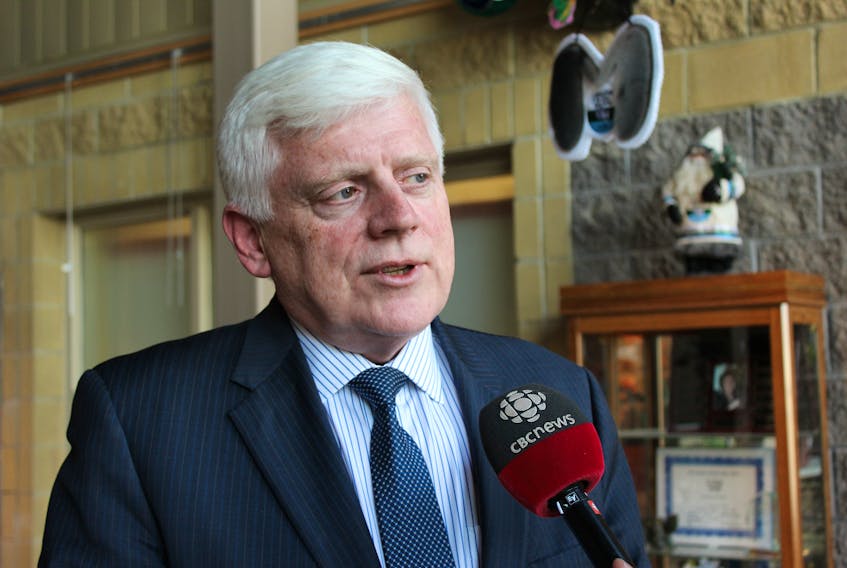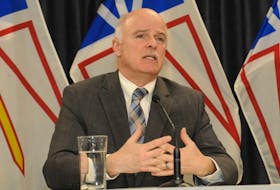A forensic audit team has determined Nalcor Energy made “potential misstatements” in examining the options for powering Newfoundland and Labrador, ahead of the decision to sanction the Muskrat Falls hydroelectric project.
The cost of an “interconnected” power option – where the island of Newfoundland would be linked to the mainland of Canada – was potentially understated, according to auditors David Malamed and Scott Shaffer, reporting to the inquiry now reviewing the project.
The cost of an “isolated” power option – where the island of Newfoundland and its power system would not be linked to the mainland – was potentially overstated, according to their report.
“The combination of these potential misstatements may have resulted in the interconnected island option (the option selected by Nalcor) no longer being considered the least cost option at the time of sanctioning,” they stated.
Essentially, Muskrat Falls may not have been the cheapest option.
RELATED STORY:
Audit report on Muskrat Falls sanctioning – Grant Thornton
In addition, the auditors found Nalcor Energy did not have talks with Hydro Quebec on the potential purchase and import of power to Labrador, before dismissing that as an option. It also says the idea to hold off on a major project until 2041, when the Upper Churchill power contract would expire, was dismissed as an option early on.
“Further analysis of these options may have led to a different decision (in how to best supply power),” the report states.

David Vardy, a leading member of the Muskrat Falls Concerned Citizens Coalition, said the report is a vindication for advocates against the project as sanctioned in 2012.
“What we’re seeing here now is this forensic audit is really confirming the major issues we have had with this from the beginning,” Vardy said during a break in proceedings. “And, you know, if the information that the forensic auditors have presented, Grant Thornton have presented, was available to the Public Utilities Board (in 2011), we believe the Public Utilities Board would have made a strong recommendation that this project ought not to go forward.”
The citizens’ coalition also issued a statement Friday, taking the Grant Thornton findings of “potential misstatements” a step further.
“It is now abundantly clear that Nalcor understated the costs of the Muskrat Falls project so as to get the project sanctioned,” the citizens’ group stated.
Former Nalcor Energy president and CEO Ed Martin, who is also represented at the inquiry, says the coalition members are speaking too soon, and there’s more evidence to be brought forward on the audit report for a full picture.
“There are many, many very strong points yet to be made,” he said.
Martin mentioned, as an example, auditors highlighting $500 million of “strategic risk exposure” for the Muskrat Falls project being excluded in cost estimates. Auditors said project team members indicated they expected the province would cover it. In speaking to The Telegram, Martin mentioned power sales outside the province, and income he expected over the life of the project, not included in the calculations used to determine the best options for adding power.
Martin also said auditors found the approach taken by the Crown corporation to be reasonable in many instances — instances not being mentioned by the coalition. That includes the decision not to pursue certain alternatives for supplying power to the province, including the use of large amounts of wind on the island, or natural gas.
“Nothing has come to our attention which would suggest Nalcor’s treatment of wind as an alternative energy source was unreasonable at the time of sanction (for Muskrat Falls),” the audit report stated, after summarizing the review of the option. A similar statement was made in the report regarding natural gas.
Isolated or connected?
Nalcor Energy and the Progressive Conservative government boiled down the decision to two options: an “isolated island” option for supplying power and the interconnected (ultimately Muskrat Falls) option. They were compared using what’s called a determination of “cumulative present worth” or CPW.
Many factors get included in the CPW, including, but not limited to, existing power generation and provincial capability to produce power; the load forecast (or demand for power); capital cost estimates for the options; fuel costs; and operating and maintenance costs.
But in looking at possibly keeping the island grid of Newfoundland isolated, auditors observed Nalcor didn’t consider a possible decrease in demand from industrial customers, or the possibility of managing power demand, and relied on economic forecasts from the province’s Department of Finance where figures used (on population and housing starts) were found to be different from those of the Conference Board of Canada.
“Price elasticity (the effect of price on demand) was not included in planning load forecast for the general service/commercial customer sector of Newfoundland and Labrador Hydro’s utility customer (Newfoundland Power),” the report states.
Nalcor Energy also determined the contingency costs for Muskrat Falls using a probability factor, or P factor, of P50. Auditors stated, “an independent consultant used by Nalcor informed us that P-factors [for contingency] ranging from P70 to P90 are more reasonable,” preparing for the potential of greater cost overrun.
If the corporation had determined the contingency it needed to have available for Muskrat Falls at a P90 value, the report states, the estimated capital costs would have increased by about $767 million. In turn, when factored in, this would have driven up the CPW, or cumulative present worth analysis, used to compare the power options, auditors noted.
It was also noted the operating and maintenance costs for the Muskrat Falls project have changed, as announced under Nalcor Energy president and CEO Stan Marshall, from an estimated $34 million per year to $109 million per year. This would also mean the values used for the interconnected option, at the time of the original decision-making on Muskrat Falls, were lower than they should have been.
More questions on all points are expected next week when the hearings continue.









